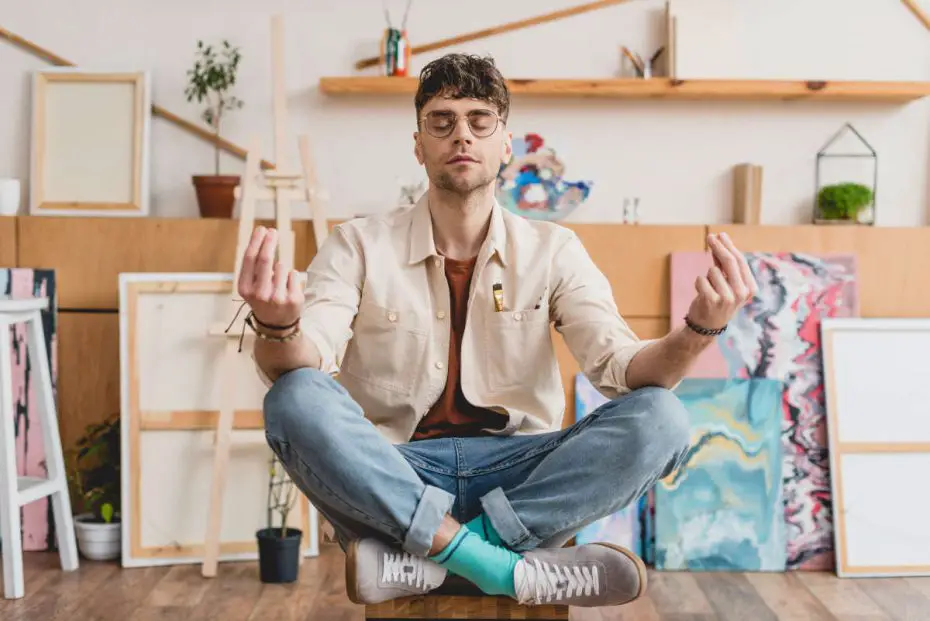Imagine a practice that cultivates inner peace while planting the seeds for your goals. That’s the magic of combining meditation and visualization. Meditation, the art of quieting the mind, becomes the fertile ground where visualization, the practice of using mental imagery, flourishes. This powerful combination can enhance your well-being, boost your focus, and empower you to achieve your aspirations.
This article explores the beautiful synergy between meditation and visualization. We’ll delve into the common ground they share, understand how meditation strengthens visualization, and explore practical techniques to seamlessly merge these practices into your daily routine. Get ready to unlock a deeper meditation experience and harness the power of your mind’s creative potential.
Synergies Between Meditation and Visualization Practices
Meditation and visualization, while distinct practices, share a beautiful common ground: intentionality. Both involve directing your mind towards a specific goal. In meditation, you might focus on your breath to quiet your thoughts. In visualization, you might create a mental image of a desired outcome. This shared foundation allows them to work together seamlessly.
At their core, both meditation and visualization cultivate:
- Focus: They train your attention to stay present in the moment, whether observing your breath or crafting a vivid mental image.
- Inner Awareness: Both practices enhance your understanding of your internal world, thoughts, and emotions.
- Relaxation: They promote a state of physical and mental ease, creating a receptive space for positive change.
Benefits of Combined Meditation and Visualization Practices
| Aspect of Well-being | Benefits |
|---|---|
| Mental Clarity | Enhances focus and concentration, reduces mental clutter |
| Emotional Resilience | Promotes emotional regulation, fosters a sense of inner calm and stability |
| Creativity | Stimulates creative thinking and problem-solving skills |
| Stress Reduction | Reduces stress levels, promotes relaxation and a sense of well-being |
| Goal Manifestation | Amplifies intention-setting and manifestation abilities, enhances goal achievement |
| Self-awareness | Deepens self-awareness and insight into one’s thoughts, emotions, and behaviors |
| Spiritual Growth | Facilitates spiritual growth and exploration, fosters a sense of connection to something greater |
Related reading: Dealing With a Wandering Mind During Meditation – Opens in new tab
Understanding How Mindfulness Enhances Visualization Effectiveness
Mindfulness, as cultivated through meditation, serves as a potent enhancer of visualization effectiveness. When we bring mindful awareness to the process of visualization, we deepen our capacity to engage with the imagined experiences fully.
By anchoring ourselves in the present moment, we sharpen our focus and clarity, amplifying the vividness and detail of our mental imagery. This heightened state of awareness not only enriches the visualization experience but also strengthens the intention behind it, increasing its potential to manifest in our reality.
Through the synergy of mindfulness and visualization, we unlock the full spectrum of our creative potential and inner resources.
Key Similarities and Differences Between the Two Practices
While meditation and visualization share common goals of promoting inner peace and self-awareness, they exhibit distinct characteristics that set them apart.
Meditation emphasizes the cultivation of non-judgmental awareness and acceptance, encouraging practitioners to observe thoughts and emotions with equanimity. In contrast, visualization involves actively directing the imagination to create desired outcomes, harnessing the power of intention and creative visualization.
Despite these differences, both practices offer valuable tools for personal growth and transformation, complementing each other in a harmonious blend of inner exploration and self-expression.

Techniques for Seamlessly Merging Meditation and Visualization
Now that we understand the beautiful synergy between meditation and visualization, let’s explore how to effortlessly integrate them into your practice.
Step-by-Step Guide to Integrating Visualization into Meditation Sessions
- Begin by establishing a comfortable meditation posture, whether seated or lying down, ensuring your spine is straight and your body relaxed.
- Settle into a state of relaxation by focusing on your breath, allowing each inhale and exhale to anchor you in the present moment. This creates a foundation of calmness and focus.
- Once you feel centered, gently introduce visualization by conjuring up a mental image that resonates with your intentions or desires. It could be a peaceful scene, a symbol representing your desired outcome, or even yourself successfully performing an action.
- Engage your senses in the visualization process, incorporating sight, sound, smell, touch, and even taste to make the imagery as vivid and immersive as possible. The richer the sensory detail, the more impactful the visualization becomes.
- As you continue to meditate, maintain awareness of both your breath and the visualized image, allowing them to coexist harmoniously in your awareness.
- If distractions arise, gently guide your focus back to the breath and the visualization, reaffirming your intention and commitment to the practice.
- Gradually deepen your visualization practice over time, exploring new images and scenarios that align with your evolving goals and aspirations.
- Finally, as your meditation session comes to a close, take a moment to express gratitude for the experience and set an intention for how you will carry the insights gained into your daily life.
Breathing Techniques to Enhance Visualization within Meditation
Breathwork is a powerful tool to elevate your visualization practice. Try this simple technique:
- Inhale Deeply: As you inhale, imagine drawing in positive energy or the essence of your visualization.
- Hold and Visualize: Hold your breath for a moment, allowing the visualization to solidify in your mind.
- Exhale and Release: As you exhale, imagine releasing any negativity or distractions, allowing your visualization to take root.
Related reading: Supercharge Your Manifestation: Using Technology for Advanced Visualization – Opens in new tab

Creating a Harmonious Flow between Meditation and Visualization
The key to seamlessly merging these practices is to cultivate patience and gentleness with yourself. Like any new skill, it takes time and practice to comfortably weave visualization into your meditation. If your visualization fades or your mind wanders, don’t get discouraged.
This is a natural part of the process. Simply refocus on your breath, the anchor of your meditation practice. As you gently bring your attention back to your visualization, imagine yourself sinking deeper into your mental imagery.
With each meditation session, you’ll develop greater ease and fluidity in moving between the state of observing your breath and engaging in your visualization. The key is to be persistent and kind to yourself throughout the journey.
Over time, meditation and visualization will naturally flow together, creating a powerful tool for inner transformation.
Tips for Seamlessly Merging Meditation and Visualization
| Tips | Description |
|---|---|
| Start Small | Begin with short visualization exercises and gradually increase the duration as you become more comfortable. |
| Establish Routine | Set aside dedicated time each day for combined meditation and visualization practice to make it a consistent habit. |
| Use Guided Practices | Utilize guided meditation and visualization recordings or apps to provide structure and support for your practice. |
| Stay Open-Minded | Approach the practice with curiosity and openness, allowing yourself to explore different techniques and experiences. |
| Practice Patience | Be patient with yourself and the process, understanding that progress may be gradual and non-linear. |
| Reflect Regularly | Take time to reflect on your experiences and insights gained from the combined practice, noting any changes or growth. |
Related reading: Finding time for meditation in a busy schedule – Opens in new tab
Addressing Common Challenges and Misconceptions in Combined Practices
Merging meditation and visualization can be incredibly rewarding, but it’s natural to encounter some bumps along the road. Here are some common challenges and how to navigate them:
- Difficulty Visualizing: If you struggle to create vivid mental images, don’t despair. Start with simple visualizations and gradually add complexity as you become more comfortable. Focus on engaging your senses – what colors do you see? What sounds do you hear?
- Mind Wandering: Your mind will naturally wander during meditation, and that’s okay. When this happens, gently acknowledge the distraction and refocus on your breath, the anchor of your meditation practice. From there, you can return to your visualization.
- Consistency is Key: Stick to a schedule that works for you, prioritizing self-care and inner exploration.
- Feeling Like “Nothing is Happening”: Visualization isn’t always about grand, dramatic imagery. Sometimes, the most effective visualizations are subtle. Trust the process and focus on the intention behind your visualization – the feeling you want to cultivate.
- Visualization Fades: Sometimes, your visualization might fade during meditation. This is normal. Just use your breath as an anchor to bring your attention back and gently re-engage with your mental imagery.

Here are some misconceptions to clear up:
- Visualization Needs to Be Perfect: Don’t strive for flawless mental images. The key is to create a visualization that resonates with you, even if it’s imperfect.
- Meditation Should Be Effortless: It’s natural to experience challenges during meditation. The practice itself is about cultivating awareness of these challenges and learning to let them go.
- Perception of Passivity: Understand that meditation and visualization are active practices that empower individuals to engage with their inner world. Embrace the dynamic interplay between inner exploration and outer experience for transformative growth.
By understanding these common hurdles and reframing any misconceptions, you can approach your combined meditation and visualization practice with greater ease and confidence. Remember, consistency is key! The more you practice, the more comfortable and effective this powerful technique will become.
Common Challenges and Solutions
| Common Challenges | Solutions |
|---|---|
| Difficulty maintaining focus during visualization | Start with short visualization sessions and gradually increase duration. Practice mindfulness techniques to anchor focus. |
| Feeling frustrated by lack of immediate results | Cultivate patience and trust in the process. Focus on the journey rather than the outcome. |
| Struggling to find time for combined practice | Schedule dedicated time for meditation and visualization, even if it’s just a few minutes each day. |
| Doubts about ability to visualize | Start with simple images and practice regularly. Remember that visualization is a skill that improves with time and effort. |
Related reading: How to Use Visualization to Accomplish Your Goals – Opens in new tab
Exploring Different Meditation Styles in Conjunction with Visualization
The beauty of combining meditation and visualization lies in its versatility. Different meditation styles can be seamlessly interwoven with visualization to address specific goals and preferences. Here are a few popular combinations to explore:
Mindfulness Meditation and its Compatibility with Visualization
Mindfulness meditation, focusing on the present moment without judgment, is a natural fit for visualization. As you train your attention to observe your breath in mindfulness meditation, you can easily transition to holding a clear and vivid visualization in your mind’s eye. This practice is excellent for cultivating focus, reducing stress, and promoting inner peace.
Loving-Kindness Meditation and Visualization for Positive Emotions
Loving-kindness meditation, also known as Metta meditation, cultivates feelings of compassion and goodwill towards oneself and others. This practice pairs beautifully with visualization. Imagine sending or receiving love and kindness as a warm light or positive energy. This visualization can significantly enhance the positive emotions fostered by loving-kindness meditation.
Transcendental Meditation and Visualization: A Symbiotic Approach
Transcendental Meditation (TM) involves using a mantra, a repeated sound or word, to transcend thoughts and achieve a state of deep relaxation. Visualization can be a complementary tool during TM. As you practice TM and experience deep relaxation, you might choose to briefly visualize a calming image or symbol to enhance your experience. However, visualization is not the core focus of TM, and it’s important to maintain your focus on the mantra during practice.
This is not an exhaustive list. Experiment with different meditation styles and see which ones resonate most with you. The key is to find a practice that feels comfortable and allows you to seamlessly integrate visualization for a truly transformative experience.
End Words
The journey of combining meditation and visualization is a path to cultivate inner peace, unlock your creative potential, and empower yourself to achieve your goals. By weaving visualization into your meditation practice, you tap into a powerful wellspring of well-being and personal growth.
Remember, this is a practice, not a performance. Be patient with yourself, celebrate your progress, and embrace the unique experiences that arise on this transformative journey. As you delve deeper into this practice, you’ll discover a newfound sense of calm, clarity, and the ability to manifest your desires with greater intention and focus.
So, take a deep breath, close your eyes (if comfortable), and embark on this exciting exploration of the limitless potential that lies within you.
Do you want to learn more about Meditation? Check out our recommendations at “Meditation Bookshelf” and many free resources at our “Free MeditationLibrary“ – Opens in new tab
Sources for further study
- Blankert T, Hamstra MR. Imagining Success: Multiple Achievement Goals and the Effectiveness of Imagery. Basic Appl Soc Psych. 2017 Jan 2;39(1):60-67. doi: 10.1080/01973533.2016.1255947. Epub 2016 Dec 7. PMID: 28366970; PMCID: PMC5351796.
- Keng SL, Smoski MJ, Robins CJ. Effects of mindfulness on psychological health: a review of empirical studies. Clin Psychol Rev. 2011 Aug;31(6):1041-56. doi: 10.1016/j.cpr.2011.04.006. Epub 2011 May 13. PMID: 21802619; PMCID: PMC3679190.
- Burnett Heyes S, Pictet A, Mitchell H, Raeder SM, Lau JYF, Holmes EA, Blackwell SE. Mental Imagery-Based Training to Modify Mood and Cognitive Bias in Adolescents: Effects of Valence and Perspective. Cognit Ther Res. 2017;41(1):73-88. doi: 10.1007/s10608-016-9795-8. Epub 2016 Aug 8. PMID: 28239214; PMCID: PMC5306169.
Stay in Touch
 Join our newsletter by using the forms on this website or click here!
Join our newsletter by using the forms on this website or click here! Follow us on Google News
Follow us on Google News Follow us on Facebook
Follow us on Facebook
Featured image from Depositphotos






